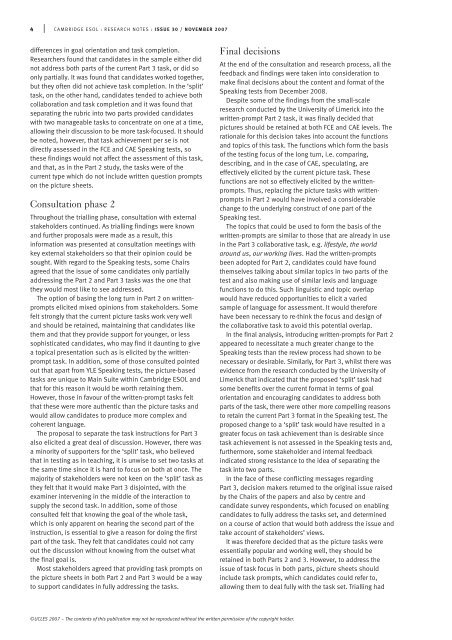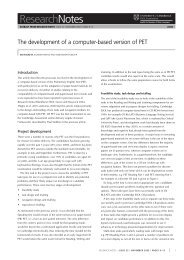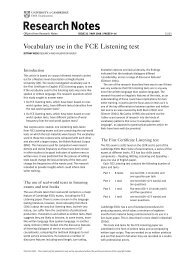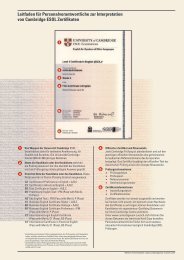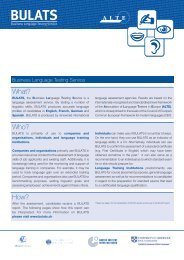Reviewing the FCE and CAE Speaking tests
Reviewing the FCE and CAE Speaking tests
Reviewing the FCE and CAE Speaking tests
Create successful ePaper yourself
Turn your PDF publications into a flip-book with our unique Google optimized e-Paper software.
4 | CAMBRIDGE ESOL : RESEARCH NOTES : ISSUE 30 / NOVEMBER 2007differences in goal orientation <strong>and</strong> task completion.Researchers found that c<strong>and</strong>idates in <strong>the</strong> sample ei<strong>the</strong>r didnot address both parts of <strong>the</strong> current Part 3 task, or did soonly partially. It was found that c<strong>and</strong>idates worked toge<strong>the</strong>r,but <strong>the</strong>y often did not achieve task completion. In <strong>the</strong> ‘split’task, on <strong>the</strong> o<strong>the</strong>r h<strong>and</strong>, c<strong>and</strong>idates tended to achieve bothcollaboration <strong>and</strong> task completion <strong>and</strong> it was found thatseparating <strong>the</strong> rubric into two parts provided c<strong>and</strong>idateswith two manageable tasks to concentrate on one at a time,allowing <strong>the</strong>ir discussion to be more task-focused. It shouldbe noted, however, that task achievement per se is notdirectly assessed in <strong>the</strong> <strong>FCE</strong> <strong>and</strong> <strong>CAE</strong> <strong>Speaking</strong> <strong>tests</strong>, so<strong>the</strong>se findings would not affect <strong>the</strong> assessment of this task,<strong>and</strong> that, as in <strong>the</strong> Part 2 study, <strong>the</strong> tasks were of <strong>the</strong>current type which do not include written question promptson <strong>the</strong> picture sheets.Consultation phase 2Throughout <strong>the</strong> trialling phase, consultation with externalstakeholders continued. As trialling findings were known<strong>and</strong> fur<strong>the</strong>r proposals were made as a result, thisinformation was presented at consultation meetings withkey external stakeholders so that <strong>the</strong>ir opinion could besought. With regard to <strong>the</strong> <strong>Speaking</strong> <strong>tests</strong>, some Chairsagreed that <strong>the</strong> issue of some c<strong>and</strong>idates only partiallyaddressing <strong>the</strong> Part 2 <strong>and</strong> Part 3 tasks was <strong>the</strong> one that<strong>the</strong>y would most like to see addressed.The option of basing <strong>the</strong> long turn in Part 2 on writtenpromptselicited mixed opinions from stakeholders. Somefelt strongly that <strong>the</strong> current picture tasks work very well<strong>and</strong> should be retained, maintaining that c<strong>and</strong>idates like<strong>the</strong>m <strong>and</strong> that <strong>the</strong>y provide support for younger, or lesssophisticated c<strong>and</strong>idates, who may find it daunting to givea topical presentation such as is elicited by <strong>the</strong> writtenprompttask. In addition, some of those consulted pointedout that apart from YLE <strong>Speaking</strong> <strong>tests</strong>, <strong>the</strong> picture-basedtasks are unique to Main Suite within Cambridge ESOL <strong>and</strong>that for this reason it would be worth retaining <strong>the</strong>m.However, those in favour of <strong>the</strong> written-prompt tasks feltthat <strong>the</strong>se were more au<strong>the</strong>ntic than <strong>the</strong> picture tasks <strong>and</strong>would allow c<strong>and</strong>idates to produce more complex <strong>and</strong>coherent language.The proposal to separate <strong>the</strong> task instructions for Part 3also elicited a great deal of discussion. However, <strong>the</strong>re wasa minority of supporters for <strong>the</strong> ‘split’ task, who believedthat in testing as in teaching, it is unwise to set two tasks at<strong>the</strong> same time since it is hard to focus on both at once. Themajority of stakeholders were not keen on <strong>the</strong> ‘split’ task as<strong>the</strong>y felt that it would make Part 3 disjointed, with <strong>the</strong>examiner intervening in <strong>the</strong> middle of <strong>the</strong> interaction tosupply <strong>the</strong> second task. In addition, some of thoseconsulted felt that knowing <strong>the</strong> goal of <strong>the</strong> whole task,which is only apparent on hearing <strong>the</strong> second part of <strong>the</strong>instruction, is essential to give a reason for doing <strong>the</strong> firstpart of <strong>the</strong> task. They felt that c<strong>and</strong>idates could not carryout <strong>the</strong> discussion without knowing from <strong>the</strong> outset what<strong>the</strong> final goal is.Most stakeholders agreed that providing task prompts on<strong>the</strong> picture sheets in both Part 2 <strong>and</strong> Part 3 would be a wayto support c<strong>and</strong>idates in fully addressing <strong>the</strong> tasks.Final decisionsAt <strong>the</strong> end of <strong>the</strong> consultation <strong>and</strong> research process, all <strong>the</strong>feedback <strong>and</strong> findings were taken into consideration tomake final decisions about <strong>the</strong> content <strong>and</strong> format of <strong>the</strong><strong>Speaking</strong> <strong>tests</strong> from December 2008.Despite some of <strong>the</strong> findings from <strong>the</strong> small-scaleresearch conducted by <strong>the</strong> University of Limerick into <strong>the</strong>written-prompt Part 2 task, it was finally decided thatpictures should be retained at both <strong>FCE</strong> <strong>and</strong> <strong>CAE</strong> levels. Therationale for this decision takes into account <strong>the</strong> functions<strong>and</strong> topics of this task. The functions which form <strong>the</strong> basisof <strong>the</strong> testing focus of <strong>the</strong> long turn, i.e. comparing,describing, <strong>and</strong> in <strong>the</strong> case of <strong>CAE</strong>, speculating, areeffectively elicited by <strong>the</strong> current picture task. Thesefunctions are not so effectively elicited by <strong>the</strong> writtenprompts.Thus, replacing <strong>the</strong> picture tasks with writtenpromptsin Part 2 would have involved a considerablechange to <strong>the</strong> underlying construct of one part of <strong>the</strong><strong>Speaking</strong> test.The topics that could be used to form <strong>the</strong> basis of <strong>the</strong>written-prompts are similar to those that are already in usein <strong>the</strong> Part 3 collaborative task, e.g. lifestyle, <strong>the</strong> worldaround us, our working lives. Had <strong>the</strong> written-promptsbeen adopted for Part 2, c<strong>and</strong>idates could have found<strong>the</strong>mselves talking about similar topics in two parts of <strong>the</strong>test <strong>and</strong> also making use of similar lexis <strong>and</strong> languagefunctions to do this. Such linguistic <strong>and</strong> topic overlapwould have reduced opportunities to elicit a variedsample of language for assessment. It would <strong>the</strong>reforehave been necessary to re-think <strong>the</strong> focus <strong>and</strong> design of<strong>the</strong> collaborative task to avoid this potential overlap.In <strong>the</strong> final analysis, introducing written-prompts for Part 2appeared to necessitate a much greater change to <strong>the</strong><strong>Speaking</strong> <strong>tests</strong> than <strong>the</strong> review process had shown to benecessary or desirable. Similarly, for Part 3, whilst <strong>the</strong>re wasevidence from <strong>the</strong> research conducted by <strong>the</strong> University ofLimerick that indicated that <strong>the</strong> proposed ‘split’ task hadsome benefits over <strong>the</strong> current format in terms of goalorientation <strong>and</strong> encouraging c<strong>and</strong>idates to address bothparts of <strong>the</strong> task, <strong>the</strong>re were o<strong>the</strong>r more compelling reasonsto retain <strong>the</strong> current Part 3 format in <strong>the</strong> <strong>Speaking</strong> test. Theproposed change to a ‘split’ task would have resulted in agreater focus on task achievement than is desirable sincetask achievement is not assessed in <strong>the</strong> <strong>Speaking</strong> <strong>tests</strong> <strong>and</strong>,fur<strong>the</strong>rmore, some stakeholder <strong>and</strong> internal feedbackindicated strong resistance to <strong>the</strong> idea of separating <strong>the</strong>task into two parts.In <strong>the</strong> face of <strong>the</strong>se conflicting messages regardingPart 3, decision makers returned to <strong>the</strong> original issue raisedby <strong>the</strong> Chairs of <strong>the</strong> papers <strong>and</strong> also by centre <strong>and</strong>c<strong>and</strong>idate survey respondents, which focused on enablingc<strong>and</strong>idates to fully address <strong>the</strong> tasks set, <strong>and</strong> determinedon a course of action that would both address <strong>the</strong> issue <strong>and</strong>take account of stakeholders’ views.It was <strong>the</strong>refore decided that as <strong>the</strong> picture tasks wereessentially popular <strong>and</strong> working well, <strong>the</strong>y should beretained in both Parts 2 <strong>and</strong> 3. However, to address <strong>the</strong>issue of task focus in both parts, picture sheets shouldinclude task prompts, which c<strong>and</strong>idates could refer to,allowing <strong>the</strong>m to deal fully with <strong>the</strong> task set. Trialling had©UCLES 2007 – The contents of this publication may not be reproduced without <strong>the</strong> written permission of <strong>the</strong> copyright holder.


